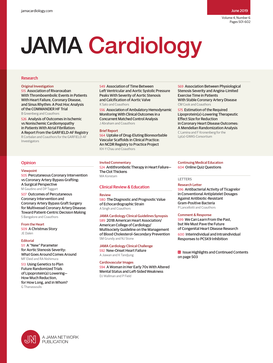Survival After Initial Stress Testing vs Anatomic Testing in Suspected Coronary Artery Disease
IF 14.1
1区 医学
Q1 CARDIAC & CARDIOVASCULAR SYSTEMS
引用次数: 0
Abstract
ImportanceSymptoms suggestive of coronary artery disease (CAD) often require noninvasive testing for diagnostic and prognostic evaluation.ObjectiveTo determine long-term outcomes in patients randomized to functional (stress) vs anatomic (coronary computed tomographic angiography [CTA]) initial testing.Design, Setting, and ParticipantsThis study is a 2025 follow-up analysis of mortality of participants in the PROMISE (Prospective Multicenter Imaging Study for Evaluation of Chest Pain) randomized clinical trial, which was conducted from 2009 to 2014, using a 2024 National Death Index search. Median (IQR) follow-up duration was 10.6 (9.9-11.3) years; maximum follow-up was 12.4 years. PROMISE was conducted at 193 multispecialty outpatient sites in North America among 10 003 symptomatic patients requiring testing for suspected CAD. Data analysis was conducted from August 2024 to March 2025.InterventionParticipants were randomized 1:1 to initial CTA or stress testing. Testing and subsequent care were performed by sites according to usual practices.Main Outcomes and MeasuresThe PROMISE trial’s original primary end point was death, myocardial infarction, unstable angina hospitalization, or major procedural complication. The primary end point for extended follow-up was all-cause death, with cardiovascular (CV) death as a secondary end point.ResultsAt enrollment, mean (SD) participant age was 61 (8) years, 5270 participants (52.7%) were women, and 8762 (87.6%) had chest pain or dyspnea. Death occurred in 1128 participants (14.4%), including 558 (14.3%) in the CTA arm and 570 (14.5%) in the stress arm (unadjusted hazard ratio [HR], 0.98; 95% CI, 0.87-1.10). There was no demonstrable difference in cardiovascular mortality, although the point estimate favored CTA (HR, 0.84; 95% CI, 0.67-1.05; adjusted HR, 0.89; 95% CI, 0.41-1.94). There were no significant interactions between all-cause death or CV death and study arm by age (<60 or ≥60 years) (疑似冠状动脉疾病患者初始应激试验与解剖试验后的生存率
提示冠状动脉疾病(CAD)的症状通常需要无创检测来进行诊断和预后评估。目的确定随机分为功能性(应激)和解剖性(冠状动脉ct血管造影[CTA])初始测试的患者的长期预后。设计、环境和参与者本研究是对2009年至2014年进行的PROMISE(前瞻性胸痛评估多中心影像学研究)随机临床试验中2025名参与者的死亡率进行随访分析,使用2024年国家死亡指数搜索。中位(IQR)随访时间为10.6(9.9-11.3)年;最长随访时间为12.4年。PROMISE在北美193个多专科门诊进行,共有10003名有症状的患者需要进行疑似CAD检测。数据分析时间为2024年8月至2025年3月。干预措施参与者按1:1随机分配到初始CTA或压力测试。测试和随后的护理由现场按照惯例进行。PROMISE试验最初的主要终点是死亡、心肌梗死、不稳定型心绞痛住院或主要手术并发症。延长随访的主要终点为全因死亡,心血管(CV)死亡为次要终点。结果入组时,参与者平均(SD)年龄为61(8)岁,5270名参与者(52.7%)为女性,8762名参与者(87.6%)有胸痛或呼吸困难。1128名参与者(14.4%)死亡,其中558名(14.3%)在CTA组,570名(14.5%)在应激组(未调整风险比[HR], 0.98; 95% CI, 0.87-1.10)。心血管死亡率没有明显差异,尽管点估计偏向于CTA(风险比0.84;95% CI, 0.67-1.05;校正风险比0.89;95% CI, 0.41-1.94)。全因死亡或CV死亡与年龄(60岁或≥60岁)(相互作用的P值= 0.19)、性别(相互作用的P值= 0.60)或种族和民族(相互作用的P值= 0.47)之间没有显著的相互作用。CTA显示任何程度的异常,包括轻度(非阻塞性CAD)、中度和重度,均可导致调整后的死亡危险比升高(1.99-3.44;P <;001)与正常研究结果相比。在压力测试结果中,只有严重异常具有预后意义(HR, 1.45; 95% CI, 1.10-1.91)。在90天存活患者的里程碑式分析中,随机试验与他汀类药物(相互作用的P值= 0.22)、β受体阻滞剂(相互作用的P值= 0.76)或抗血小板药物(相互作用的P值= 0.49)的使用之间没有相互作用。结论和相关性在PROMISE随机临床试验的长期随访中,在症状稳定的疑似CAD患者中,最初的无创检查选择对10年的全因或CV死亡率没有影响。临床试验注册号:NCT01174550
本文章由计算机程序翻译,如有差异,请以英文原文为准。
求助全文
约1分钟内获得全文
求助全文
来源期刊

JAMA cardiology
Medicine-Cardiology and Cardiovascular Medicine
CiteScore
45.80
自引率
1.70%
发文量
264
期刊介绍:
JAMA Cardiology, an international peer-reviewed journal, serves as the premier publication for clinical investigators, clinicians, and trainees in cardiovascular medicine worldwide. As a member of the JAMA Network, it aligns with a consortium of peer-reviewed general medical and specialty publications.
Published online weekly, every Wednesday, and in 12 print/online issues annually, JAMA Cardiology attracts over 4.3 million annual article views and downloads. Research articles become freely accessible online 12 months post-publication without any author fees. Moreover, the online version is readily accessible to institutions in developing countries through the World Health Organization's HINARI program.
Positioned at the intersection of clinical investigation, actionable clinical science, and clinical practice, JAMA Cardiology prioritizes traditional and evolving cardiovascular medicine, alongside evidence-based health policy. It places particular emphasis on health equity, especially when grounded in original science, as a top editorial priority.
 求助内容:
求助内容: 应助结果提醒方式:
应助结果提醒方式:


